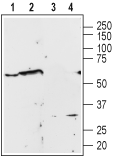Overview
- Peptide EDETI*SQINEEPG(C), corresponding to amino acid residues 171-183 of human α1A-adrenoceptor with replacement of cysteine 176 (C176) with serine (*S) (Accession P35348). 2nd extracellular loop.
- Human prostate carcinoma (PC3) cell line lysate and rat brain membrane (1:200).
 Western blot analysis of Human PC3 prostate carcinoma cell line lysate (lanes 1 and 3) and rat brain membrane (lanes 2 and 4):1,2. Anti-α1A-Adrenergic Receptor (extracellular) Antibody (#AAR-015), (1:200).
Western blot analysis of Human PC3 prostate carcinoma cell line lysate (lanes 1 and 3) and rat brain membrane (lanes 2 and 4):1,2. Anti-α1A-Adrenergic Receptor (extracellular) Antibody (#AAR-015), (1:200).
3,4. Anti-α1A-Adrenergic Receptor (extracellular) Antibody, preincubated with α1A-Adrenergic Receptor (extracellular) Blocking Peptide (#BLP-AR015).
- Rat cerebellum (1:100).
Adrenergic receptors (also called adrenoceptors) are the receptors for the catecholamines adrenaline and noradrenaline (called epinephrine and norepinephrine in the United States). Adrenaline and noradrenaline play important roles in the control of blood pressure, myocardial contractile rate and force, airway reactivity, and a variety of metabolic and central nervous system functions.
Adrenergic receptors are members of the G-protein coupled receptor (GPCR) superfamily of membrane proteins. They share a common structure of seven putative transmembrane domains, an extracellular amino terminus, and a cytoplasmic carboxyl terminus.
Adrenoceptors are divided into three types: α1, α2 and β adrenoceptors. Each type is further divided into at least three subtypes: α1A, α1B, α1D, α2A, α2B, α2C, β1, β2, β3.1,2 They are expressed in nearly all peripheral tissues and in the central nervous system.1,2
All α1-adrenoceptors (α1-ARs) activate phospholipases C and A2.3 In addition to mobilizing intracellular calcium, the α1-ARs have also been shown to activate calcium influx via voltage-dependent and -independent calcium channels.4
The α1A-ARs have at least nine known alternative spliced isoforms. They are the most abundant adrenergic receptor in the brain, and are considered postsynaptic receptors. α1A-ARs are also expressed in the heart, liver and prostate.
